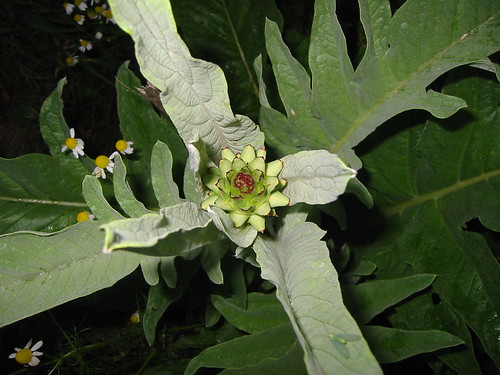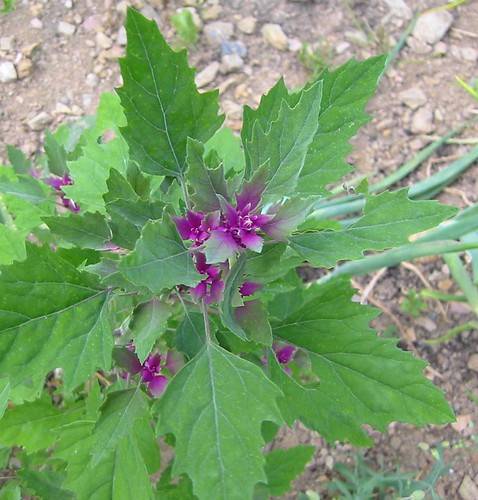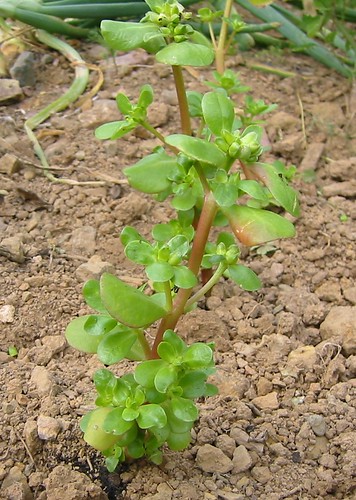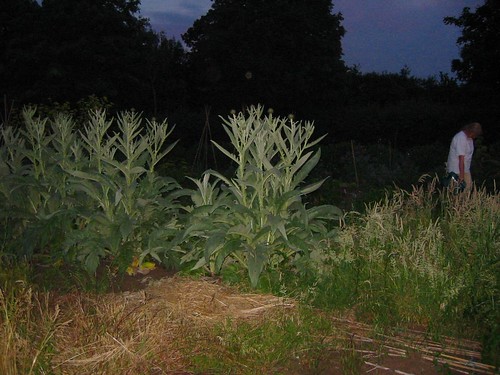
Cardoon flower
Although they look a lot like artichokes, Cardoons; Cynara cardunculus, are grown for their leaf stalks which are tied up and blanched, a bit like celery, for use as a cooked vegetable. I've never actually done this, although we have been growing cardoons for several years since we inherited a patch on our allotment in Newport Pagnell. I've seen large fields of them in preparation for the markets on the east coast of Spain around Valencia but they are an unusual vegetable for UK and as far as I can tell for Northern France.
The plants are perennial and can be propagated from slips or offsets which form around the parent plant. It's also possible to start from seed but we've found it easy to keep ours going by regular vegetative reproduction. They seem slightly hardier than artichokes and since we haven't been worrying about eating them, just enjoying their statuesque architecture and thistly flowers our patch is rather cruelly treated. It keeps going.

Magentaspreen
We first grew the annual chenopod, Magentaspreen; Chenopodium giganteum, as a novelty five or more years ago. It's been with us ever since. I was shocked to discover two months after we first came over here that there were seedlings of it growing in the gravel of the yard. Seeds which must have fallen out of pots that I thought had been cleaned up for the journey. It's a survivor!
Although I wonder the appropriateness about introducing another prolific alien into the environment it is barely more than funny Fat Hen and can be used as green vegetable (but take it young). It will grow taller than a person so hoick it out pronto if it's in the wrong place, its vigour will weaken all around it.

Golden Purslane
Purslane; Portulaca oleracea, is one of my all time favourite vegetables used most often in salads but also in cooked dishes. It has a fleshy texture and a slightly sharp taste which holds up well under dressings.
The one in the picture is described as Golden and this is often suggested to be best flavoured but it seems little different to the green version we've grown before. Once you have it, again it will stay. The plant looks a little weedy because I left it too late to get seed for this year and was seduced into buying an expensive pack of plants at the HDRA at Ryton when we were there last. I will save a little seed but I expect to find seedlings happily popping up all by themselves next year as soon as the weather warms up.

Scuplit
Which brings us finally to Scuplit. Way back when I was looking for large bean seeds I found seeds for this plant, which seemed entirely new to me on the Seeds of Italy site. It's actually Bladder Campion; Silene inflata (or vulgaris), a native (or possibly naturalised) plant of most of Europe including the UK but it seems it's only used as a herb in Italy.
I have to say it's a bit backward in coming forward on flavour. Seeds of Italy suggested it was somewhere between Tarragon and Rocket, I'd say grass might be closer. It doesn't like being photographed much either, you can't really see the bladder heads of the flowers in this shot.
Maybe it will grow on me, Good King Henry did when I gave it a chance but at the moment it seems more like an addition to the wild flower meadow than a useful vegetable.

Cardoons by Night
1 comment:
i love cardoons. we brought ours with us when we moved this spring but they aren't thriving. may have to start again next year.
Post a Comment